Search the Special Collections and Archives Portal
Search Results
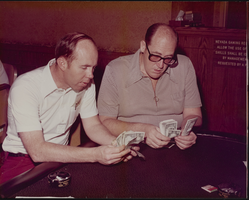
Photograph of Jack Binion and Doyle Brunson counting money, Las Vegas, Nevada, 1979
Date
Archival Collection
Description
Jack Binion (left) and Doyle Brunson counting money at the 1979 World Series of Poker, Binion's Horseshoe Hotel.
Image
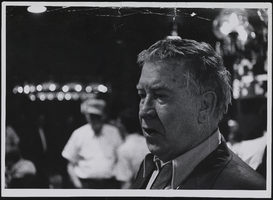
Photograph of Chill Wills' profile, 1970-1989
Date
Archival Collection
Description
Chill Wills, movie actor and friend of Benny Binion. (c. 1970s-1980s).
Image
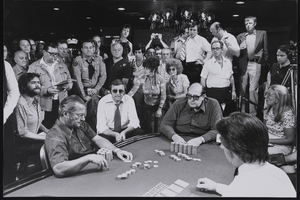
Photograph of gamblers at the 7th World Series of Poker, Las Vegas (Nev.), 1976
Date
Archival Collection
Description
Doyle Brunson, also known as "Texas Dolly," the bald man with dark-rimmed glasses seated at end of table, won $300,000 in this 7th World Series of Poker held at the Horseshoe Casino in Las Vegas. The photo shows "Texas Dolly" and other players playing poker while a large crowd watches them the background. Site Name: Horseshoe Club (Las Vegas, Nev.)
Image
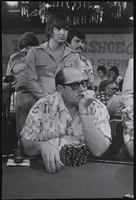
Photograph of Brunson playing poker, Las Vegas (Nev.), 1976
Date
Archival Collection
Description
Adrian Doyle Brunson plays poker at Binions (known as "Texas Dolly") and standing directly behind Texas Dolly is player Eric Drache, watching him play as he wins wins $300,000 at Binion's Horseshoe Casino's World Series of Poker. Site Name: Horseshoe Club (Las Vegas, Nev.)
Image
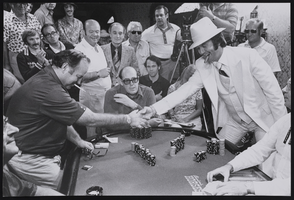
Photograph of two men shaking hands at a poker tournament, Las Vegas (Nev.), 1976
Date
Archival Collection
Description
At the end of the table we can see another view of Doyle Brunson who won $300,000 in the Seventh World Series of Poker, Horseshoe Casino, Las Vegas. Standing in the white suit and hat is Crandall Addington shaking hands with another poker player at the table. Site Name: Horseshoe Club (Las Vegas, Nev.)
Image
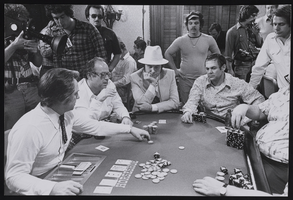
Photograph of men playing poker at World Series tournament, Las Vegas (Nev.), 1976
Date
Archival Collection
Description
A table of players in the Horseshoe Casino's Seventh World Series of Poker playing an intense game, thinking about their next move. Site Name: Horseshoe Club (Las Vegas, Nev.)
Image
Title page and table of contents to the dictionary Lanman wrote and correspondence including letters from James W. Nye and William M. Stewart, 1864-1868
Level of Description
Archival Collection
Collection Name: Charles Lanman Papers
Box/Folder: Box SH-009
Archival Component
Valerie Pida Trust correspondence, newspaper clippings, financial statements, and receipts, 1987 to 1993
Level of Description
Archival Collection
Collection Name: Valerie Pida Trust Records
Box/Folder: Box 01 (Restrictions apply)
Archival Component
Binion's Horseshoe Club and Benny Binion's personal photographs, approximately 1940 to 1985
Level of Description
Archival Collection
Collection Name: Binion’s Horseshoe Club Photograph Collection
Box/Folder: Oversized Box SH-065, Box SH-032
Archival Component

Transcript of roundtable interview about Kristallnacht with Esther Finder, Raymonde Fiol, Alexander Kuechel, Philipp Meinecke and Rabbi Felipe Goodman, by Barbara Tabach, March 17, 2015
Date
Archival Collection
Description
In this interview, the participants discuss their experiences during Kristallnacht, and the commemoration events in southern Nevada with Holocaust survivors and their families. Mr. Kuechel recounts his journey through concentration camps and being liberated by the Russians. Rabbi Goodman talks about meeting Mr. Meinecke, whose grandfather was a high-ranking SS officer. Meinecke discusses his upbringing in Germany and trying to learn about his family's involvement in the Holocaust, and the hope he felt after the fall of the Berlin Wall as Jews returned to Germany. The group discusses the importance of Holocaust education because there are still so many untold stories.
On November 9th to November 10th, 1938, in an incident known as Kristallnacht, Nazis in Germany torched synagogues, vandalized Jewish homes, schools and businesses, and killed close to one hundred Jews. In the aftermath of Kristallnacht, also called the Night of Broken Glass, some thirty thousand Jewish men were arrested and sent to Nazi concentration camps. German Jews had been subjected to repressive policies since 1933 when Nazi Party leader Adolph Hitler became chancellor of Germany. However, prior to Kristallnacht these Nazi policies had been primarily nonviolent. However, after Kristallnacht conditions for German Jews grew increasingly worse. During World War II, Hitler and the Nazis implemented their so-called final solution to what they referred to as "the Jewish problem" and carried out the systematic murder of some six million European Jews in what is now commonly known as the Holocaust.
Text
